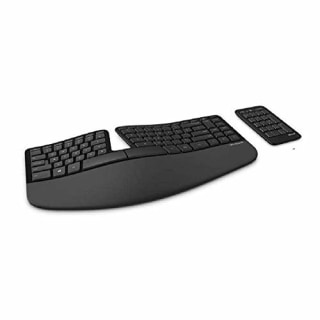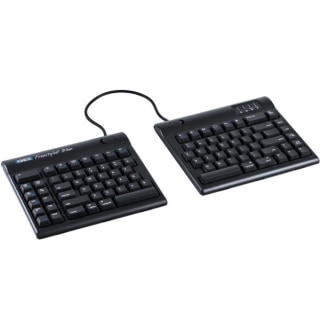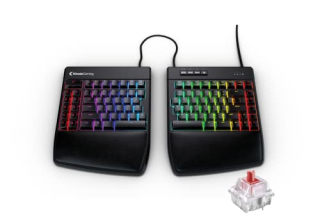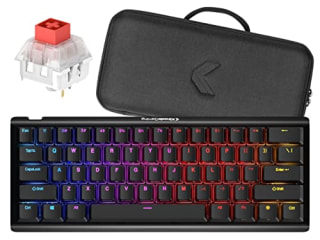Working long hours in front of the computer can be taxing on your body. That’s why many experts recommend investing in ergonomic office chairs and standing desks.
These larger items can be helpful for improving posture and supporting your spine, but they are not the only ways to upgrade your workstation.
The keyboard is another tool we use everyday, often incorrectly, by overextending our fingers and wrists to make up for bad typing habits, according to experts. Common typing mistakes include “not typing in a neutral wrist posture, bending up into wrist extension or bending to the side in ulnar deviation,” says Alan Hedge, professor emeritus and former director of the human factors and ergonomics lab at Cornell University.
People with wrist and hand injuries can alleviate specific typing-induced stresses by using an ergonomic keyboard, which encourages a more neutral and natural typing posture, according to experts.
We spoke with experts to learn more about ergonomic keyboards and their recommendations for the best models, though some of them say that despite anecdotal results there are not significant scientific studies to confirm these beneficial effects.
SKIP AHEAD The best ergonomic keyboards | How to shop for an ergonomic keyboard | How to use an ergonomic keyboard | Do ergonomic keyboards work?
Our top picks
- Expert pick: Microsoft Sculpt Ergonomic Keyboard (for Business)
- Best split keyboard: Kinesis Freestyle 2 Blue
- Best gaming keyboard: Kinesis Gaming TKO 60%
How we picked the best ergonomic keyboards
To pick the best ergonomic keyboards, we relied on expert advice from specialists. Based on their guidance, we selected options that stood out in the following areas:
Size: We only selected keyboards that omit the number pad, or include it as a separate attachment that you can place anywhere at your workstation. Doing so can help “alleviate excessive reaching with your mousing hand” says Karen E. Loesing, ergonomic consultant and owner of The Ergonomic Experts.
Layout: Most ergonomic keyboards come in either a traditional layout or split layout. A traditional layout is what you are used to on a laptop or standard keyboard: all the keys together in a QWERTY arrangement. A split layout halves the keyboard at the center, leaving a small to large gap in between the two halves of the keyboard. This encourages a neutral posture by placing your hands and wrist in line with your shoulders. It also prevents you from reaching with one hand, for example, your left hand, to type on a key that’s closer to your right hand. We tried and included both types in our recommendations.
Adjustability: We chose adjustable keyboards that complement many different typing needs.
The best ergonomic keyboards
To find the best ergonomic keyboards on the market, Select staffers tried our top picks for a full working week. Most of our top picks came from brands like Microsoft and Kinesis that offer a wide variety of standard and ergonomic keyboards. We also included recommendations based on expert guidance.
Expert pick:
What we like: Sculpted design, separate number pad
Both Loesing and Select contributor Rebecca Isaacs’ recommend this keyboard. “As a user of this keyboard for over six months, it’s become my go-to for when I find myself typing for hours in my home office,” says Isaacs. Since buying the Microsoft Sculpt in 2021, Isaacs’ hypermobility wrist pains have disappeared.
The center of this keyboard is slightly raised, creating a swooping slope that helps place your wrists and forearms in a more neutral position, according to the brand. Typing on the keys also feels smooth and isn’t too noisy, according to Isaacs.
One of the best parts of this keyboard is the separate number pad, which you can place anywhere on your desk to add flexibility to your typing experience, according to Loesing.
Connectivity: Wireless via USB dongle | Layout: Split | Battery: 2 AAA batteries | Backlighting: No
Best split keyboard:
What we like: Comfortable, Bluetooth connectivity
If you are looking to try a split keyboard, the Kinesis Freestyle 2 Blue is a Bluetooth compatible option for both PC and Mac. The pieces of the keyboard are connected with a cable that allows up to 9 inches of separation between the two halves, accommodating for a range of shoulder widths.
Select updates editor Mili Godio found typing on this keyboard light and comfortable. It has no slope, leading to a flat hand position while typing. The keyboard also has a rubber membrane, which is soft and clicky to type on. “It didn’t slide around when I was typing — which I find many keyboards do,” says Godio.
Like any split keyboard, the Kinesis Freestyle 2 takes some getting used to: Godio used this keyboard in the office for a week, and it took her two to three times longer on average to type on, compared to her traditional full-sized Dell keyboard.
Loesing recommends using this keyboard with the Kinesis VIP accessories kit, which allows you to angle the keyboard to your specific typing needs. If you need a number pad, Kinesis sells the Freestyle2 number pad separately.
Connectivity: Bluetooth, up to three connected devices | Layout: Split | Battery: Rechargeable | Backlighting: No
Split keyboard for gaming:
What we like: Multi-color lighting, clicky keys
Light-up keys and a split design come together in the Kinesis Gaming Freestyle Edge. It has a 20-inch long cable that connects the two keyboard halves together, so you can adjust their position based on your needs. Typing is soft and smooth, says Select senior social media editor Rosalie Tinelli. The customizable backlighting is a fun addition to the otherwise utilitarian-look.
The left side of the keyboard has nine programmable keys that you can set to specific inputs in games and software. This model also comes with removable wrist rests on each half of the keyboard.
Like other split keyboards, this keyboard took some getting used to. For added ergonomic customization, Kinesis offers a lift kit that lets you angle the keyboard in a variety of ways.
Connectivity: Wired | Layout: Split | Battery: N/A | Backlighting: Yes, programmable multicolor
Best ergonomic gaming keyboard:
What we like: Highly adjustable
The Kinesis Gaming TKO 60% keyboard is a great option for gamers who want a customizable, ergonomic keyboard with a traditional form factor. It is a small model that does not have a function row, arrow keys or additional modifiers like delete, page or home keys. Its compact size frees up mouse space on my desk, which I find great for gaming.
One of my favorite parts of this keyboard are its adjustable feet. There’s one on each corner that snaps out at two different heights, allowing you to prop this keyboard at different angles. The flexibility allowed me to try a range of typing and gaming setups, though I preferred the standard, flat layout in the end.
This keyboard comes with a carrying case, multiple space bar options and a few extra key switches too.
Connectivity: Wired | Layout: Traditional | Battery: N/A | Backlighting: Yes, programmable multicolor
How to shop for an ergonomic keyboard
Ergonomic keyboards are designed to improve comfort and reduce fatigue, according to Don Patten, an ergonomics specialized service lead at Workplace Safety and Prevention Services (an occupational health and safety advisory group out of Ontario, Canada). They generally come in a traditional or split design, which allows users to position their hands more naturally by minimizing excessive wrist or finger bending, says Patten.
When shopping for an ergonomic keyboard, buying something simply labeled “ergonomic” may not solve anything. What’s more important is getting a product with the right fit for your individual needs, says Patten.
Look for keyboards that help you position your arms and wrists in a neutral posture, according to Loesing.
“If you can balance a dime on the back of your hand while you type, then your hands are probably in a fairly neutral posture,” says Hedge. Features like an adjustable split design, angled keyboards and keys that are light and easy to type on can help you maintain a comfortable typing posture.
Loesing also recommends ergonomic keyboards without a number keypad attached. For right-handed users, a keyboard without an attached number keypad is shorter, and “allows the mouse to stay nice and close to the keyboard, alleviating excessive reaching with your mousing hand,” she says. Left-handed mouse users will not have this problem, as most extended keys like number and shortcut keys are on the right side of traditional keyboards.
How to use an ergonomic keyboard
We tried ergonomic keyboards in the office and found them comfortable, but difficult to use. At first, they significantly reduced our typing speed and overall work productivity since many of us were new to trying ergonomic models. Overtime, we got more used to them, and worked closer to our normal speeds. If you are trying an ergonomic keyboard for the first time, expect a transition period as you adjust to a new typing experience. “At first, I had to switch back to a traditional keyboard when I needed to get something done quickly because I felt that I wasn’t able to type efficiently on a split ergonomic keyboard,” says Tinelli.
When using a regular or ergonomic keyboard, Hedge says to place it in front of your body, so there is no unnecessary twisting of the hands, arms and torso. To reduce risk of injury, he also says to incorporate voice input into your work routine for simple tasks like texts and emails, as this can give your hands a rest.
Do ergonomic keyboards work?
While some acknowledge the positives that ergonomic keyboards offer like improved comfort, posture and performance, there has not been scientific testing to verify those health benefits, according to Hedge and Patten. Currently, there is a lack of empirical research on ergonomic keyboards.
Still, our experts say that ergonomic keyboards can help users who find traditional keyboards uncomfortable due to stress or injury.
Meet our experts
At Select, we work with experts who have specialized knowledge and authority based on relevant training and/or experience. We also take steps to ensure all expert advice and recommendations are made independently and without undisclosed financial conflicts of interest.
Karen E. Loesing is the owner of The Ergonomic Expert, a consulting company for ergonomic office evaluations.
Don Patten is a certified professional ergonomist and the specialized services lead in ergonomics for Workplace Safety and Prevention Services (WSPS) in Ontario, Canada.
Alan Hedge is a professor emeritus and the former director of human factors and ergonomics at Cornell University. He is currently the president of Humanuse, an ergonomic consulting group.
Why trust Select?
Harry Rabinowitz is a reporter for Select who has covered tech for years. For this piece, he spoke with ergonomic experts and consultants to better understand ergonomic keyboards. He referenced expert research, including Alan Hedge’s research on keyboard systems and muscle activity at Cornell University. Alongside expert recommendations, Rabinowitz and Select staffers used different ergonomic keyboards in the office for a week.
Catch up on Select's in-depth coverage of personal finance, tech and tools, wellness and more, and follow us on Facebook, Instagram and Twitter to stay up to date.










